Toward a Sensory Theatre / Hacia un Teatro Sensorial
Which of our senses are the ones that normally perceive an artistic manifestation? About two years ago I asked myself this question, and it led me to the following: Sight and hearing are the predominant senses we use when experiencing live arts. Some of the very terms we use in the field support this statement, such as viewer, spectator (from Latin spectator, spectatoris, means the one with the habit of watching or observing), or audience (from Latin audire, to listen). I’ll even go as far as stating that this isn’t exclusive to the arts, but also evident in every aspect of daily life in which we tend to focus our attention on those things we perceive through sight and hearing, while we put taste, smell, and touch in the background.
While our senses are instinctual, we humans tend to restrict our interactions with the world around us. As a result, some senses become lethargic.
Every encounter allows me to register new possibilities to involve the senses in the creation, and it helps me to keep sharing this initiative that can lead us to new innovative and intriguing artistic roads.
How has my artistic production been affected by this relationship with the senses?
How can we incorporate all the senses when developing and sharing theatre? An important turning point was my encounter with the idea of Body Mind Centering (BMC). BMC is a research process connected to dance, that explores the sources of the movement in the body. Bonnie Brainbridge Cohen started this research in the 1960s.
During the first BMC session I attended, we explored sense of every kind except for visual stimuli to create a short improvised solo. After that experience, I decided to study new tools to work in a performance with all the senses. I started to explore smell, taste, and touch in two ways. First, I used them as an improvisational source of inspiration. Secondly, I tried to use them as a bond with the people participating in the performance as an invitation to become co-creators.
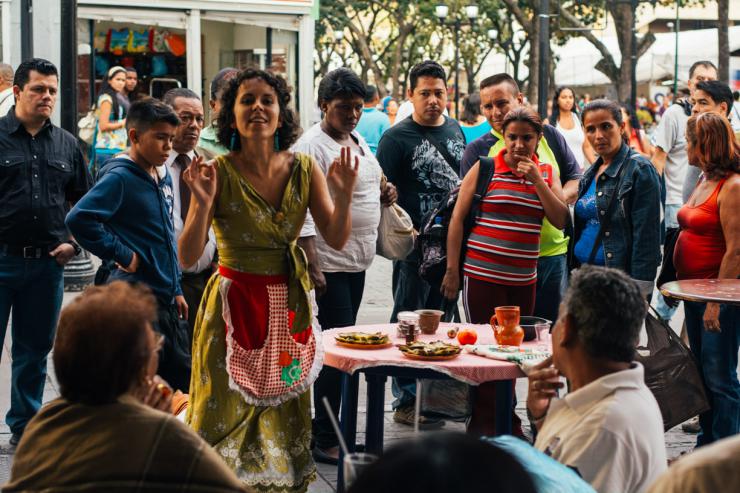
My First Steps
After the BMC session, I traveled to Spain in February 2014. My intention was to create a short sample to share that same year at a woman's performing arts festival called Vértice in Brazil. I created a short performance; a hybrid between a physical theatre demonstration, storytelling, and clowning. I called it Theater Recipes because the format is similar to a food tasting.
I started picking up some of the ideas I got during my first BMC session. First, I received sensory stimuli from objects in daily life, and after that I chose the ones that made me feel more curious. I tried strong and subtle smells, from floral scents to rotting food. I passed through a wide variety of smells with different qualities and intensities: styptic, sweet, relaxing, nauseating, etc. I did the same with taste. I experienced a good amount of flavors, from food seasoning to ready-to-eat products. I tried raw food, food almost rotten, and food with artificial additives to boost the flavor. I approached touch from diverse objects, but in the end I decided to focus on the touch of food ingredients because the whole exploration seemed to be heading that way.
The support of my colleague Laura de Arcos was very important. She specializes in body awareness with the Shinca technique that partially comes from Laban, and using it she guided me through the beginning of the physical exploration.
Our session involved: the election of one of the stimuli, the description with precise adjectives of the stimuli, and then seeking physical actions to integrate those adjectives. The intention was to give them different qualities to embody diverse characters.
During this phase, three elements came together: the first one was the physical and emotional state I unconsciously sensed because of the stimuli, the second one was the intentional adjective we used to name the sensations in transit, and the third one was the automatic associations I made in my mind with previous life experiences.
One of the stimuli I was interested in was the taste of boiled artichoke. That was the starting point, so I tasted the artichoke several times and then I described the sensations that arose in me: a smooth taste, subtle, delicious, surprising, playful, fleeting, and peculiar. The next step was to explore the possible movements. Following Laura's proposals, I tried different qualities of movement to express these adjectives. We worked with breathing retention, fluid and wavy movements, tapping movements, very precise changes of rhythm, and finally we played a little bit with the voice. The result of this playful phase was a prototype of a young character; a cheerful teenager, hoppy, a dreamer, nervous, and constantly moving.
We followed this work plan with all the stimuli, three in total, and that is how we built the physicality of them. Finally, we tried to find a proposal to unify them, keeping always in mind the premise of creating a bond with the public, trying to put it in a more active/participative role in the creative process.
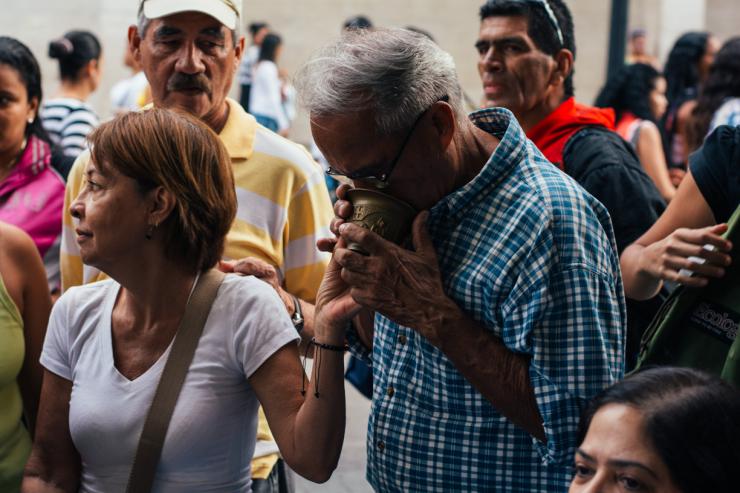
The Scenic Proposal
I decided that the most sincere and modest thing to do was to show the process itself, without creating an introductory character, to get closer to the participants. It was then when the idea of a food tasting improvisation appeared.
The main “course” was a simple scene: a woman setting the table to welcome a special guest. The idea of the intervention/performance was to prepare this scene three times, each of them from a different recipe inspired by the smell, taste, and touch. During the demo the participants also entered in touch with the sensory stimuli and shared the sensations they felt while experiencing them. This way, they interacted with the performance from another perspective and it allowed them to become co-creators.
I was able to finish the pilot scheme on time to show it at the Vértice festival, and the following month I shared it with the students of the Estúdio Cênico (Scene Studio) in Campinas, Brazil. After evaluating these two experiences, I wanted to keep developing the performance and I felt the next step was to find the way to blend all the elements together to tell a story. After living in Brazil I moved to Venezuela, my home country, for a season, and there I decided to add some sort of storytelling to the piece to integrate the three recipes.
Following a friend's suggestion, I chose the children’s tale The Three Little Pigs and thought about adapting the story to the twenty-first century. Instead of three male little pigs, I chose three female little pigs, and each of them is inspired by one of the recipes from the beginning of the demo. I also kept the interactive proposal and invited the people to play the role of the wolf.
I had the chance to perform in three different spaces in Caracas city: at a gallery, on the street, and in the terrace of a cafe-bar. The experience on the street was the more dynamic, but in general they were all really interesting, because they allowed me to collect a diversity of reactions and ways of interacting with the participants depending on the space.
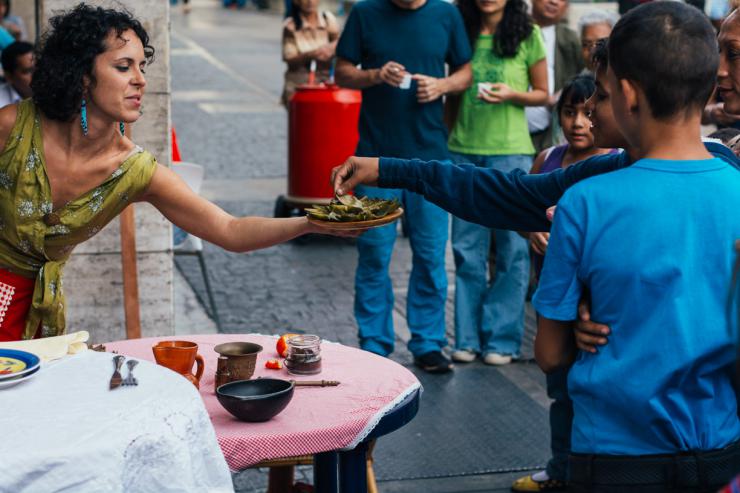
Inspiration
I remembered a theatre performance from the company Cuarta Pared called Café (Madrid, 2005). In that performance the attendants were welcomed with a cup of coffee, and thanks to the scent and the taste of that beverage, they managed to make the people get inside the story from a different perspective.
I also thought of the work of the Théâtre du Soleil during their performance Les Naufragés du Fol Espoir (La Cartucherie, Paris 2010) where they welcomed people in a shed that immediately took them to the late XIX century, and they offered a “Soupe de la champagne” (a wintery soup), to start introducing everyone into the dreamed space of the story.
After some research I came across other companies and groups that focus their work in the senses. One of them, the Theatre of the Senses (Teatro de los Sentidos), as the name implies, focus its research in different sensory languages and how they relate to performing arts. The group is based in Barcelona and has been following this path for over twenty years.
There are also performing proposals for people with diverse abilities, like the Teatro a ojos vendados (Blindfolded Theatre), a Mexican company that develops plays based on sensory proposals, for both Blind and sighted people.
The continuity of this research
This project was the seed of a new research line as a performance creator. I am still interested in developing it more, and I am slowly evaluating possible paths to do it.
At the moment, I consider the next step is to open up more the improvisation, because therein liess the real potential to integrate the suggestions of the participants. If this happens, the movement score can even change completely in each performance.
Another line of research I started in Brazil and then kept exploring in Venezuela and Canada is the body awareness workshops based on sensory proposals. These encounters are great for any person, with or without previous experience in the area.
Every encounter allows me to register new possibilities to involve the senses in the creation, and it helps me to keep sharing this initiative that can lead us to new innovative and intriguing artistic roads.
There is a beautiful journey ahead, full of smells, flavors, contacts, and emotions.
***
Hacia un Teatro Sensorial
¿Con cuáles de nuestros sentidos percibimos usualmente una manifestación artística? Hace casi dos años me hice esta pregunta y me llevó a plantearme la siguiente hipótesis: Los sentidos predominantes a la hora de experimentar el arte son la vista y el oído. Algunos términos que utilizamos en el ámbito de las artes sirven para apoyar este enunciado, por ejemplo: espectador (del latín spectator, spectatoris, que significa el que tiene el hábito de mirar y observar) o audiencia (del latín audire, oír).Incluso me atrevo a decir que no solo en el arte, sino en muchos otros ámbitos de la vida cotidiana, solemos centrar nuestra atención en lo que perciben estos dos sentidos, mientras que mantenemos adormecidos los demás, es decir, el gusto, el olfato y el tacto.
Ahora bien, la especie humana además de responder al instinto de supervivencia está condicionada por su construcción moral, y de allí que al relacionarnos con el mundo generemos otras restricciones que nos llevan a aletargar algunos sentidos.
¿Cómo me ha afectado esta relación con los sentidos dentro de mi producción artística?
Después de llegar a esta conclusión, me propuse reflexionar sobre cómo podrían integrarse todos los sentidos a la hora de gestar y presentar una obra de arte, y me interesé especialmente en enfocar la investigación en las relaciones que se propician entre todos los individuos que participan en el fenómeno artístico.
Un punto de inflexión importante para mí fue el encuentro con el Body Mind Centering (BMC). El BMC es una línea de investigación ligada a la danza que explora el origen del movimiento en el cuerpo. Fue iniciada por Bonnie Brainbridge Cohen en la década de 1960.
Durante la primera sesión de BMC a la que asistí utilizamos estímulos sensoriales, de todo tipo menos visuales, para crear un breve solo improvisado. A partir de esta experiencia decidí investigar nuevas formas de expresión escénica en sintonía con todos los sentidos.
Comencé a experimentar con el olfato, el gusto y el tacto en dos niveles distintos. Primero, los utilicé como fuente de inspiración, y segundo, los utilicé como vínculo con los receptores de la manifestación artística para invitarlos a convertirse en co-creadores.
Mis primeros pasos
El desarrollo creativo comenzó en España en febrero del 2014, y la intención era compartir el resultado en abril dentro del encuentro de mujeres creadoras Vértice (Brasil). El resultado de mis primeros pasos ha sido una breve intervención escénica a caballo entre demostración de trabajo y cuenta cuentos. La terminé titulando Recetas de teatro ya que se fue construyendo con el estilo de una degustación culinaria.
Comencé retomando lo experiencia del taller de BMC. Durante varias sesiones me dediqué a impregnarme de estímulos sensoriales con objetos cotidianos del hogar y al final seleccioné los que generaban en mí más curiosidad.
Probé con olores fuertes y delicados, desde esencias florales hasta alimentos en descomposición. Pasé por una gran diversidad de calidades e intensidades olfativas: aromas astringentes, dulces, nauseabundos, relajantes, expectorantes, etc.
Lo mismo hice con los sabores, experimenté una buena gama de ellos, desde condimentos hasta alimentos procesados. Degusté comida cruda, comida que empezaba a descomponerse y aditivos para potenciar los sabores.
Al tacto me aproximé desde objetos muy variados, pero finalmente decidí centrarme en el tacto de los alimentos ya que todo parecía encaminarse en esa dirección.
Conté con el apoyo de una colega especializada en didáctica de expresión corporal, Laura de Arcos, quien me guió durante la fase de exploración física a través de la técnica Schinca, la cual se deriva parcialmente de Laban.
Nuestras sesiones consistían en: escoger uno de los estímulos sensoriales planteados, describirlo con adjetivos precisos y realizar acciones físicas que integrasen esos adjetivos para otorgarles diferentes cualidades.
Durante este período se aunaron tres elementos; el primero fue el estado físico y emocional que generaba de forma inconsciente el estímulo en mí, el segundo fueron los adjetivos con los que nombramos las sensaciones producidas, y el tercero fueron las asociaciones mentales que hice de forma automática con otras vivencias personales.
Uno de los estímulos que me interesó fue el sabor de la alcachofa cocida. Partiendo de este punto, degusté varias veces la alcachofa y luego describí la sensación que me producía: es un sabor ligero, sutil, delicioso, sorprendente, juguetón, fugaz y particular. El segundo paso fue la exploración del movimiento. Con la guía de Laura, fui probando diferentes cualidades físicas que pudieran expresar esos adjetivos. Trabajamos con la retención de la respiración, movimientos fluidos y ondulados, movimientos de tecleo, cambios de ritmo bastante marcados, y finalmente dejamos que apareciera la voz aunque no centramos la atención en ella. El resultado de esta fase de juego fue un prototipo de personaje joven; una especie de adolescente alegre, saltarina, enamoradiza, muy nerviosa y en continuo movimiento.
Mantuvimos este esquema de trabajo y así fuimos dotando de forma física a todos los demás estímulos sensoriales, en total 3. Finalmente, buscamos una propuesta que los unificara, con la intención de crear, a través de la misma, un vínculo con el llamado “público”, para colocarlo en una posición más activa dentro de la creación.
La propuesta escénica
Decidí que lo más sincero y modesto era mostrar cómo fue el proceso de investigación en sí, sin personaje inicial, para poder aproximarme más a los participantes. Fue entonces cuando apareció la idea de una intervención-improvisación escénica inspirada en una degustación culinaria.
El “plato” a preparar era una escena sencilla: una mujer coloca la mesa para recibir a una persona especial. La intervención consistía en crear esa escena a partir de tres recetas diferentes; una inspirada en el sentido del olfato, otra en el gusto, y la última en el tacto.
Durante la demostración los participantes también entraron en contacto con los tres estímulos sensoriales y compartieron la sensaciones que les produjeron. Esto les permitió aproximarse a la obra desde otra perspectiva y convertirse en co-creadores.
El piloto conseguí terminarlo a tiempo para estrenarlo en el encuentro Vértice, y luego se lo presenté a los alumnos del Estúdio Cênico en Campinas- Brasil.
Después de evaluar estas dos primeras experiencias, me di cuenta de que era necesario continuar con la creación y buscar la forma de unir todos los elementos de la demostración para contar una historia. De Brasil me trasladé por una temporada a Venezuela, en dónde decidí añadir un cuento a la propuesta escénica para poder integrar las tres recetas iniciales y le darle un sentido global a toda la intervención.
Por sugerencia de una amiga escogí la historia infantil de Los tres cerditos y me dispuse a contarla en clave de clown y adaptada al siglo XXI. En la nueva versión en lugar de ser cerditos machos son tres hembras, y cada una está inspirada en una de esencia de las recetas que se degustaron al principio de la intervención. También continué con la propuesta participativa invitando a los asistentes a representar al lobo.
Tuve la oportunidad de presentar el resultado en tres espacios diferentes en la ciudad de Caracas: en una galería, en la calle y en la terraza de un café. La experiencia en la calle fue la más dinámica, pero en general fue interesante recoger las diferentes reacciones de los participantes según el espacio en el que nos encontrábamos.
¿De dónde podían venir las referencias para iniciar este proceso de investigación y creación?
Buscando referentes cercanos me fui atrás en el tiempo y recordé un montaje teatral de la compañía Cuarta Pared llamado Café (Madrid, 2005). En dicho montaje el público era recibido con una taza de café, y gracias al aroma y al sabor del mismo conseguían que los asistentes se sumergieran en la historia de otra manera.
También tuve presente el trabajo del Théâtre du Soleil, quienes durante su montaje Les Naufragés du Fol Espoir (La Cartucherie, París 2010) recibían a las personas en un espacio que las transportaba a finales del siglo XIX, y las invitaban a tomar una sopa servida al estilo 'la campagne', para empezar a introducirlas en el mundo soñado de la historia.
Indagando más, encontré otras compañías y colectivos que han enfocado su trabajo en la exploración de los sentidos. Uno de ellos, el Teatro de los Sentido, como su nombre mismo lo indica, centra su investigación en los lenguajes sensoriales y su relación con la creación teatral. El colectivo tiene sede en Barcelona y trabaja en esta línea desde hace más de 20 años.
Hay también grupos que crean propuestas para personas con diversidad funcional, como el Teatro a ojos vendados, una compañía mexicana que desarrolla obras, tanto para ciegos como videntes, a partir de propuestas sensoriales.
Continuando con esta línea de investigación
Este proyecto ha sido la semilla de una nueva línea de trabajo como creadora. Sigo interesada en desarrollarlo más y poco a poco voy evaluando caminos posibles para ello.
Actualmente, considero que el siguiente paso es abrirme aún más a la improvisación para poder integrar en profundidad las sugerencias de los participantes al instante. De esta forma la partitura de movimiento llegará incluso a cambiar completamente en cada representación.
Otra vía de investigación, que abrí en Brasil y luego continué en Venezuela y después Canadá, son los talleres de expresión corporal basados en la exploración sensorial. Estos talleres son un espacio interesante para trabajar con cualquier persona sin importar su experiencia previa en este ámbito.
Cada encuentro me permite registrar nuevas formas de involucrar los sentidos en la creación, y me ayuda a seguir compartiendo esta iniciativa que nos puede llevar por nuevos derroteros artísticos innovadores e intrigantes.
Hay por delante una hermosa travesía llena de olores, sabores, contactos y emociones.

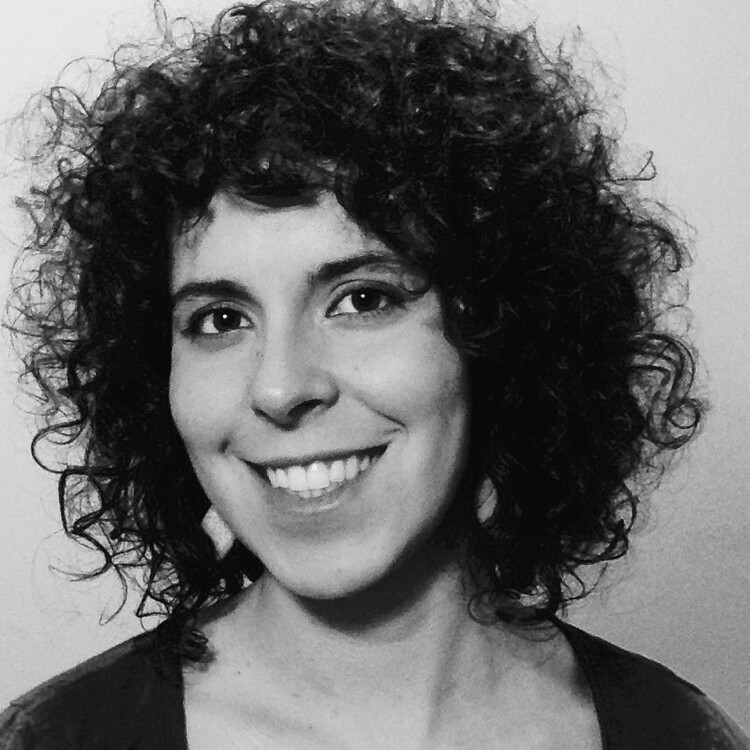
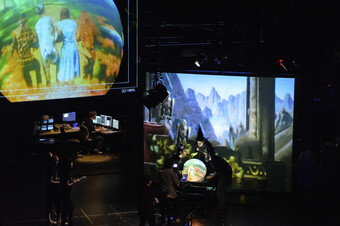

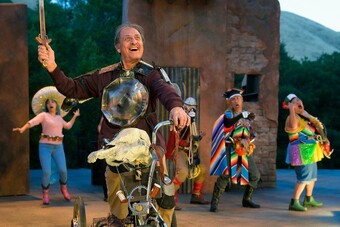




Comments
The article is just the start of the conversation—we want to know what you think about this subject, too! HowlRound is a space for knowledge-sharing, and we welcome spirited, thoughtful, and on-topic dialogue. Find our full comments policy here
Such a vivid piece. Thanks for sharing, Beatriz!